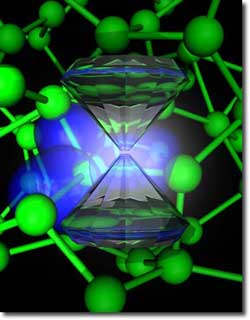Livermore researchers shed new light on the physical properties of carbon

Graphic simulation of the electronic wave function (MLWF) in liquid carbon at a temperature of 9,000°Kelvin and five million atmospheres of pressure, showing a persistent covalent bonding even under these extreme conditions. At this pressure diamond melts at about 8,000°K.
A team based in Livermore has shed some new light on the phase diagram of carbon at high pressure and temperature.
In particular, the authors determined the solid/liquid and solid/solid phase boundaries for pressures up to 20 million Earth atmospheres and more than 10,000 degrees Kelvin. The simulations provide results on the physical properties of carbon, which are of great importance for devising models of Neptune, Uranus and white dwarf stars, as well as of extrasolar carbon-rich planets.
In its elemental form, carbon is found in coal, graphite, diamond, bucky balls and nanotubes. These are materials with very different properties, yet at the microscopic level they only differ by the geometrical arrangements of carbon atoms.
Elemental carbon has been known since prehistory, and one of its best known forms, diamond, is thought to have been first mined in India more than 2,000 years ago. The properties of diamond and its practical and technological applications have been extensively investigated for many centuries.
Despite important experimental work over the last few decades aimed at studying compressed diamond, the phase boundaries and melting properties of elemental carbon are poorly known, and its electronic properties under extreme conditions are not well understood. Experimental data are scarce because of difficulties in reaching megabar (one million atmospheres) pressures and temperature regimes of thousands of degrees Kelvin in the laboratory.
The research team is composed of Alfredo Correa, Stanimir Bonev and Giulia Galli, all of whom were at Lawrence Livermore National Laboratory (LLNL) at the time the work began. Galli is now a professor at UC Davis, and Bonev is an assistant professor at Dalhousie University in Canada.
“Our results show a consistent description of elemental carbon in a broad range of temperature and pressures and a description of its electronic properties within the same framework,” said Correa, a Student Employee Graduate Research Fellowship (SEGRF) student from UC Berkeley who works in LLNL’s Quantum Simulations Group in the Physics and Advanced Technology Directorate. Correa is the lead author of a paper on the recent findings that appears in the online version of the Proceedings of the National Academy of Sciences for the week of Jan. 23-27.
The researchers also discovered that the diamond/BC8/liquid triple point (the temperature and pressure at which these three phases coexist in thermodynamic equilibrium) is at a lower pressure than previously thought (BC8 denotes a solid phase of carbon into which diamond transforms above 12 megabar at zero temperature). The conditions at which the triple point is found are close to recent estimates of the core conditions (temperature and pressure) in Neptune and Uranus.
“Our simulation results call for a partial revision of current planetary models, especially for the description of their core regions,” Correa said. “Our computational work also may help us interpret future experimental work.”
Founded in 1952, Lawrence Livermore National Laboratory has a mission to ensure national security and to apply science and technology to the important issues of our time. Lawrence Livermore National Laboratory is managed by the University of California for the U.S. Department of Energy’s National Nuclear Security Administration.
Media Contact
More Information:
http://www.llnl.govAll latest news from the category: Physics and Astronomy
This area deals with the fundamental laws and building blocks of nature and how they interact, the properties and the behavior of matter, and research into space and time and their structures.
innovations-report provides in-depth reports and articles on subjects such as astrophysics, laser technologies, nuclear, quantum, particle and solid-state physics, nanotechnologies, planetary research and findings (Mars, Venus) and developments related to the Hubble Telescope.
Newest articles

Properties of new materials for microchips
… can now be measured well. Reseachers of Delft University of Technology demonstrated measuring performance properties of ultrathin silicon membranes. Making ever smaller and more powerful chips requires new ultrathin…

Floating solar’s potential
… to support sustainable development by addressing climate, water, and energy goals holistically. A new study published this week in Nature Energy raises the potential for floating solar photovoltaics (FPV)…

Skyrmions move at record speeds
… a step towards the computing of the future. An international research team led by scientists from the CNRS1 has discovered that the magnetic nanobubbles2 known as skyrmions can be…





















